Vintage Guitars Info's
Gibson Flat top Model Descriptions.
History, collecting Gibson flattop vintage guitars. Private vintage guitar collector. Pictures, history for flat top Gibson vintage guitars.
Contact the vintage guitar info guy.
Picture Gallery, Gibson section.
Gibson General Info.
Gibson Flattop Bracing: X-braced vs. Ladder braced.
Especially on low-end Gibson models, how the top is internally
braced is a huge deal in regard to collectibility and sound.
There are two styles of bracing Gibson used, Ladder and X-braced.
Ladder bracing is just how it sounds, the braces go across the top
like the runs of a ladder. X-brace is also just like it sounds,
the underside bracing forms an "X".
Gibson and Kalamazoo models used Ladder bracing on all their inexpensive guitars. It is generally thought that ladder braced guitar don't sound nearly as good as X-braced. For this reason most ladder braced models will have little collectibility.
Note Gibson flat tops (and arch tops) were made for other lesser manufacturers during the 1930s to 1950s. These budget brand guitars weren't as good as their equivalent Gibson models (lesser woods, ladder bracing, etc.), but are still somewhat cool. Brands like Kalamazoo, Kel Kroydon, National, Bellson, Forbes, Joe C Sapp, Levy Page, Oriole, Cromwell, Ambassador, Capital, Carson Robison, Fascinator, Francis Day & Hunter, Grinnell, Hayden, Martelle, Marshall Special, Henry L. Mason, Mastertone Special, Mitchell Brothers, Old Kraftsman (Spiegel), Recording King (Montgomery Ward), Reznick Radio, S.S. Stewart, Trujo – Truett, Washburn, and Werlein Leader. Gibson also made guitars as well as supplied guitar bodies for National (Valco Mfg.)
View of the inside top of two guitars, back of guitars removed.
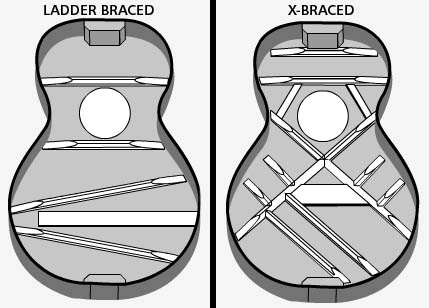
NOTE on L-0, L-00 and L-1 Gibson Flat Top Models:
The L-0, L-00 and L-1 models are very similar, and often
difficult to tell apart. Because of this, it may be easier
to use the chart after these three model's specs.
Also the L-0, L-00 and L-1 models were very lightly constructed guitars. They were inexpensive at the time (and still are!), and had light bracing, thin woods, and thin finishes. This made them sound great! But it also meant they broke easily. Putting heavy strings on one of these pre-war L-0, L-00 or L-1 guitar will literially make it come apart at the seams. These models are not built for heavy strings!
L-0 Flattop
Available: 1926 to 1942
Collectibility Rating: 13.5" wide models: D, 14.75" wide: C+.
The 1931 to 1942 models I feel are nice small bodied flat tops.
Very comparible to the L-00.
- 1926 L-0 introduction specs:
- $35 list price, 13.5" wide, 12 frets clear of body, spruce top with amber brown stain, round lower body shape, slightly arched top and back, brown stained birch back and sides, b/w/b/w/b soundhole rings (varies), ebony belly bridge with pyramids at ends and black pins, white bound top and back, dot fingerboard inlays at 5th, 7th and 9th frets, ebonized unbound fingerboard, no pickguard, 25" (approximately) scale length, 3-on-a-plate tuners usually with white buttons (or sometimes black buttons), "The Gibson" angled peghead logo in white paint.
- 1928 L-0 specs:
- 13.5" wide, natural/amber finish mahogany top, mahogany back, and sides, b/w/b/w/b soundhole rings (varies). Bottom belly bridge with raised center area (though late models have a rectangle bridge with a spare white bridge pin below other black pins), unbound rosewood fingerboard, dot fingerboard inlays at 5th, 7th, 9th frets, 3-on-strip tuners.
- 1929 L-0 specs:
- No belly to bridge, no extra bridge pin.
- 1930 L-0 specs:
- 14.75" wide lower bout (same body shape as the L-2), body more square at bottom, natural finish mahogany top, b/w/b/w/b soundhole ring, mahogany back and sides, bound top and back, rectangular rosewood with angled saddle, unbound fingerboard with dots at 3rd, 5th, 7th, 9th, 12th, 15th frets, 3-on-strip tuners.
- 1932 L-0 specs:
- 14.75" wide, top and back now flat, 14 frets clear of the body, natural finish mahogany top, mahogany back and sides, bound top and back, tortoise pickguard, retangle bridge, unbound fingerboard, 24.75" scale, dots at 3rd, 5th, 7th, 9th, 12th, 15th frets, 3-on-strip tuners, some with "Gibson" painted logo (no "the").
- 1933 L-0 discontinued.
- 1937 L-0 re-introduction specs:
- 14.75" wide, 14 frets clear, spruce top with black finish, mahogany back and sides, bound top and back, fire-striped tortoise grain pickguard retangle bridge with black bridge pins and end pin, dots at 3rd, 5th, 7th, 9th, 12th, 15th frets, 3-on-strip tuners. List price reduced to $25.
- 1942 L-0 discontinued.
Back to the Gibson General Info
Back to the Table of Contents
Contact the collector
L-1 Flattop
Available: 1926 to 1937 (note available earlier as an Archtop model).
Collectibility Rating: 13.5" wide models: D, 14.75" wide: C.
The 1931 to 1937 models I feel are nice small bodied flat tops, very comparible to the L-00.
- 1926 L-1 introduction specs:
- $50 list price, 13.5" wide, 12 frets clear of body, round lower body shape and narrow waist, slightly arched spruce top with amber stain or natural, b/w/b/w/b/soundhole rings (with black outer ring), carved birch or maple back and sides with brown dark stain, bound top and back (though some have an unbound back), unbound ebony square end fingerboard with dots at 5th, 7th, 9th frets. Fixed ebony bridge with pyramids at ends and black pins, 25" scale length, "The Gibson" straight peghead painted logo. Bracing pattern could be X,H or A.
- 1928 L-1 specs:
- 13.5" wide, spruce top with stained shaded finish, mahogany back and sides, bound top and back, b/w/b/w/b/soundhole rings (no black outer ring), bottom bellow rosewood bridge with raised center, 3-on-strip tuners, bound rosewood fingerboard with dots at 5th, 7th, 9th, 12th, 15th frets.
- 1929 L-1 specs:
- 13.5" wide, spruce top with stained shaded finish, mahogany back and sides, bound top and back, bottom bellow rosewood bridge with raised center and extra bridge pin (though later models had a rectangle bridge), 3-on-strip tuners, bound rosewood fingerboard with dots at 5th, 7th, 9th, 12th, 15th frets.
- 1930 L-1 specs:
- 14.75" wide, body more squared at bottom, 12 frets clear of body, spruce top with stained shaded finish, mahogany back and sides, bound top and back, 3-on-strip tuners, longer modern type rectangle bridge, unbound fingerboard with dots at 5th, 7th, 9th, 12th, 15th frets.
- 1932 L-1 specs:
- 14.75" wide, 14 frets clear of the body, 24.75" scale length, small sprayed sunburst finish, mahogany back and sides, bound top and back, fire striped tortoise pickguard, retangle bridge, unbound fingerboard with dots at 5th, 7th, 9th, 12th, 15th frets. Individual tuners, "Gibson" peghead logo (no "the"), reduced $37.50 list retail price.
- 1937 L-1 discontinued.
Back to the Gibson General Info
Back to the Table of Contents
Contact the collector
L-00 Flattop
Available: 1932 to 1945
Collectibility Rating: B.
I believe these are the nicest of the small bodied Gibson flat tops.
- 1932 Gibson L-00 guitar introduction specs:
- Actually introduced between 1929 and 1931 (but first catalog appearance in 1932), $25 list price. 14.75" wide, spruce top with black finish, 12 frets clear of body, mahogany back and sides, white bound top only (unbound back), white pickguard (no pickguard on later models), rectangle rosewood bridge with black bridge pins, unbound ebonized fingerboard with dots at 5th, 7th, 9th, 12th, 15th frets. "V" shaped neck, 3-on-a-plate open back strip tuners, tapered peghead, can have either "the Gibson" or "Gibson" peghead logo in white paint.
- 1933 Gibson L-00 guitar specs:
- 14.75" body, 14 frets clear of body, spruce top with small sized yellow sprayed sunburst, Scalloped X bracing, mahogany back and sides, bound top only (though occasionally a bound back too), fire-striped tortoise pickguard (or sometimes a mocking style tortoise pickguard), rectangle bridge, unbound fingerboard with dots at 5th, 7th, 9th, 12th, 15th frets. Also now has a "Gibson" peghead logo (no "the"), $27.50 list retail price.
- 1935 Gibson L-00 guitar specs:
- spruce top sunburst changes a bit with medium sized yellow sprayed sunburst,
- 1936 Gibson L-00 guitar specs:
- bound top only (though some do have a bound back now.)
- 1937 Gibson L-00 guitar specs:
- spruce top sunbrust changes yet again with a larger sized yellow sprayed sunburst. List price $30, all have back bound now. A few 3/4 scale L-00 models sold.
- 1941 Gibson L-00 guitar specs:
- Natural finish available. List price now $36.75 for sunburst, $42 for natural.
- 1943 Gibson L-00 guitar specs:
- A few L-00 models made with "Only a Gibson is Good Enough" banner peghead logo. This model is rarely seen after 1942, since the LG series of guitars replaced the L-00.
- 1945 Gibson L-00 guitar discontinued.
Note Gibson also sold a model called the HG-0 and HG-00 model. These are like a Hawaiian L-00 models but with heavier bracing, a straight bridge saddle (no slant), a more squarish neck, usually sunburst finish (sometimes black), and 12 frets clear of the body. Made from 1937 to 1942.
Back to the Gibson General Info
Back to the Table of Contents
Left: 1937 style L-0 with a firestrip pickguard.
Right: 1937 style L-00 with a "large" sunburst.
Notice these two guitar models are very similar,
and are often confused (the black L-0 has a bound back).
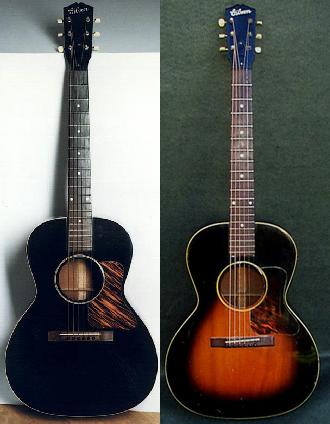
The following table (based on E.Whitford's "Fabulous Flat-Top Guitars") shows an "easy" way to tell the difference between pre-war L-0, L-00 and L-1 flat top models (which are all very similar!) First start with the color on the left. Then move right to narrow down the features, which will identify the model and approximate year.
| Body Color | Features | Model | Year |
|---|---|---|---|
| Black | white pickguard unbound back "the Gibson" logo 12 frets clear |
L-00 | 1932 |
| Black | no pickguard unbound back "the Gibson" logo 14 frets clear |
L-00 | 1932 |
| Black | white pickguard unbound back "Gibson" logo 14 frets clear |
L-00 | 1933-1936 |
| Black | L-0 reintroduced 1937 firestripe pickguard bound back 14 frets clear |
L-0 | 1937-1942 |
| Black | straight bridge saddle heavy top bracing firestripe pickguard bound back 12 frets clear |
HG-0 | 1937-1938 |
| Amber | Mahogany top 12 frets clear |
L-0 | 1930-1931 |
| Amber | Mahogany top 14 frets clear |
L-0 | 1932 |
| Amber | Mahogany top 14 frets clear L-0 discontinued 1933 |
L-0 | 1933 |
| Sunburst | white bridge pins no pickguard (or elevated PG) "small" sunburst bound back 12 frets clear |
L-1 | 1930-1931 |
| Sunburst | white bridge pins no pickguard "small" sunburst 14 frets clear |
L-1 | 1933-1936 |
| Sunburst | white bridge pins pickguard "small" sunburst bound back 14 frets clear |
L-1 | 1933-1936 |
| Sunburst | black bridge pins pickguard "small" sunburst unbound back 14 frets clear |
L-00 | 1933-1935 |
| Sunburst | black bridge pins pickguard "medium" sunburst bound or unbound back 14 frets clear |
L-00 | 1936 |
| Sunburst | black bridge pins pickguard "large" sunburst bound back 14 frets clear |
L-00 | 1937-1945 |
| Sunburst | straight bridge saddle heavy top bracing unbound back 12 frets clear |
HG-00 | 1937-1942 |
| Body Color | Features | Model | Year |
"medium sunburst" has a yellow center about 8" to 10" in diameter.
"large sunburst" has a brown edge about 2" to 3" thick.
"frets" means playable frets clear of the body (either 12 or 14, but 13 frets clear is sometimes seen).
Left: 1932 Gibson L2 in Argentine Gray sunburst with
a pin bridge, fingerboard and pickguard glued to the top,
and 12 frets clear of the body.
Right: 1932 Gibson L2 in natural finish
with an elevated pickguard and 13 frets clear.
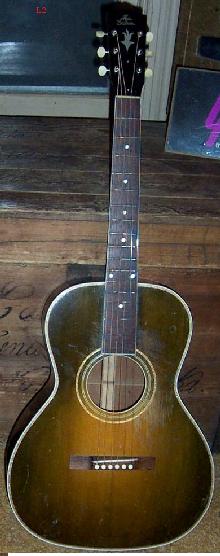
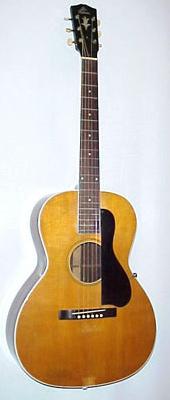
Gibson L-2 Flattop
Available: 1929 to 1934 (note available earlier as an
Archtop model).
Collectibility Rating: Rosewood models with pin bridge: B+, models with
trapeze tailpiece: C-.
The Gibson L-2 has a Nick Lucas body shape/style, but is a plainer than the Lucas.
The trapeze models I don't view as very good because the trapeze just
does not drive the top very well, limiting the sound. The rosewood models,
though not really any better in sound, have the appeal of rosewood (a body
wood that Gibson did not use on very many models). Hence the 1932-1935 L-2 with a
pin bridge is the best variant, and one I would like to find. Note this model
varies a lot in specs for any given year.
- 1929 Gibson L-2 introduction specs:
- List retail price of $75,
14.75" wide (similar to the Nick Lucas in size, but not as deep), slightly arched top
and back, rosewood back and sides, spruce top, short bridge, most
with adjustable bridge and trapeze tailpiece, "X" braced, no pickguard, trible bound
top and back, Grover 98 tuners, 13 frets clear of the body, 24.75" scale, bound ebony fingerboard,
"the Gibson" peghead logo, dot fingerboard inlays, sunburst or
natural top finish (natural most common).
- 1931 Gibson L-2 specs:
- Mahogany back and sides, longer modern type bridge,
gold sparkle inlay around top and soundhole borders, 12 frets clear of the
body, 6 point flame-shaped peghead inlay, Argentine gray sunburst finish.
- 1932 Gibson L-2 specs:
- No sparkle trim, mahogany or rosewood back and sides, pin bridge (adjustable
bridge with trapeze tailpiece optional), elevated or glued down pickguard,
raised rosewood fingerboard (or not!), 12 or 13 frets clear of the body, natural
top finish or Argentine gray sunburst finish.
- 1933 Gibson L-2 specs:
- celluloid pickguard glued to top, 14 frets clear of the body,
"Gibson" peghead logo (no "the"), mahogany or rosewood back/sides.
- 1935 Gibson L-2 discontinued.
Back to the Gibson General Info
Back to the Table of Contents
Contact the collector
1935 Nick Lucas
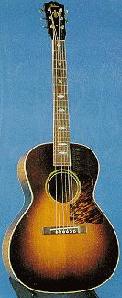
- Nick Lucas Model Flattop
- 1928 Gibson Nick Lucas guitar introduction specs:
-
$125 list price, 13.5" wide, 24.25" scale, deep
body (4 1/2" deep or more), slightly arched top and back,
mahogany back and sides, spruce top,
2 multi-ply soundhole rings, rosewood bridge with pyramids at ends,
slight belly on bridge with white pins, extra pin below bridge pins, triple bound
top & back, triple bound rosewood fingerboard, small varied-pattern fingerboard
inlays, 12 frets clear of the body,
Grover 98 tuners, angled "The Gibson" silkscreened logo, special round
"Nick Lucas" label inside, sunburst finish.
Body had same rounded shape as the Gibson L-1 and L-3.
Most Nick Lucas guitars have serial numbers indicating 1928 or 1929 -
date guitar by spec not by serial number.
- Late 1928 Gibson Nick Lucas guitar specs:
-
By the end of 1928 the peghead "The Gibson" logo was inlaid in pearl.
Also the pyramid bridge changed and the sound hole perfing changed.
Fingerboard inlays changed to a large varied pattern with notched
diamond at the 3rd fret (Roy Smeck Radio Grande style). Fleur-de-lis
peghead inlay added.
- 1929 Gibson Nick Lucas guitar specs:
- 14 1/2" wide, 24.75" scale,
12 fret neck (though sometimes 14 frets clear of the body is seen),
3-ply soundhole ring, rectangle rosewood pin bridge with no pyramids,
mahogany body with a spruce top
- 1930 Gibson Nick Lucas guitar specs:
-
raised ebony fingerboard, rosewood back and side,
usually has a trapeze tailpiece with adjustable bridge,
sometimes has rectangle pin bridge, raised pickguard,
13 frets clear of the body.
- 1932 Gibson Nick Lucas guitar specs:
-
cataloged with mahogany back and sides but in reality
most use rosewood, pin style bridge or optional adjustable trapeze
tailpiece (most seem to have the trapeze tailpiece), most have
elevated pickguard (but some have pickguard glued to top),
ebony fingerboard raised off the top.
- 1933 Gibson Nick Lucas guitar specs:
-
catalog states rosewood back and sides.
- 1934 Gibson Nick Lucas Model guitar specs:
-
retail price dropped from $125 to $90,
Maple back and sides (some with
mahogany), mahogany neck, flat back and top, pickguard glued to top, standard rectangle
pin bridge, 14 frets clear of the body, inlay at 1st fret,
sunburst finish on top, back and sides. Some made with all black finish.
- Gibson Nick Lucas guitar discontinued from catalog in 1938 with the last guitars being shipped in 1941.
Available: 1928 to 1941
Collectibility Rating: 1928-1933: B-, 1934-1941: A.
The maple back and side Nick Lucas models are excellent guitars, and one I love to play. Please contact me if you have one for sale. My personal favorites are the 1934 to 1941 models with maple back and sides.
Back to the Gibson General Info
Back to the Table of Contents
Contact the collector
1935 Gibson L-C
Photo by Folkway Music.
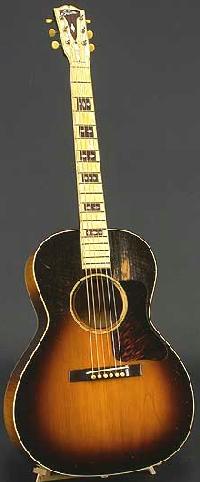
L-C (L-Century) and HG (Hawaiian) Century Models Flattop
Available: 1933 to 1941
Collectibility Rating: L-C models: B, H-G models: C-.
Many believe this model is more "show than go", as they usually do not
sound very good (too much plastic limiting the sound of the wood). But
a very pretty model. One I would love to find, because they are so
darn pretty.
- 1933 LC Century Model introduction specs:
- $55 list price, 14 3/4" wide, maple
back and sides, triple bound top & back, triple bound fingerboard, white pearloid
fingerboard and peghead veneer, notched diamond inlay within rosewood
rectangles fingerboard markers (some with hearts and flowers or wreath
pattern), 14 frets clear of the body, notched diamond peghead inlay,
"small" sunburst finish on entire body.
- 1937 H-G Century Model specs:
- Hawaiian setup, straight mounted
bridge saddle, 12 frets clear of the body, heavier bracing, "large" sunburst.
- 1938 L-C and H-G Century Models specs:
- single bound top and back,
rosewood peghead veneer with pearl "gibson" logo, pearl notched diamond or elongated diamond
peghead inlay, large sunburst.
- 1941 H-G Century Models specs:
- some with no truss rod due to war-time shortages,
some with two pearl dots on the bridge.
- L-C and H-G Century Models discontinued 1941.
Back to the Gibson General Info
Back to the Table of Contents
Contact the collector
1934 Gibson Jumbo
Photo by Folkway Music.
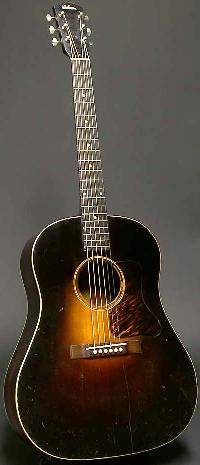
Available: 1934 to 1936
Collectibility Rating: A.
The beginnings of Gibson's 16" flattop guitar line. The 1934 Jumbo was Gibson's attempt to compete with Martin's "D" series of guitars (introduced in 1932). An excellent guitar, one I am most impressed with. Please email me if you have one for sale!
- 1934 Jumbo introduction specs:
- $60 retail list price,
16" wide body, 10.25" long body, 4.5" deep, round
shoulder dreadnought body shape, mahogany back and sides, sides taper from bottom
to top, 3.75" soundhole, bound top and back,
rectangular bridge, rosewood fingerboard, dot fingerboard inlays, pearl
logo, retangle bridge with no bolts (hence no pearl dots),
1 1/8" below the soundhole "X" bracing at 100 degrees with three tone bars,
scalloped top braces,
fire striped celluloid pickguard, unbound 1.75" wide "V" shaped
mahogany neck with a pointed French heel,
24.75" scale length, pearl "Gibson" peghead logo, nickel plated Grover G-98 tuners,
sunburst finish on top and back (top sunburst is "small", with the yellow
covering about 1/4 of the top).
- 1935 Jumbo specs:
- neck binding added, increased yellow portion of sunburst to
"medium" sized, covering about 1/3 of the top.
- Jumbo discontinued 1936.
Back to the Gibson General Info
Back to the Table of Contents
Contact the collector
Left: 1938 Sunburst Gibson J-35
Right: 1941 Natural Gibson J-35
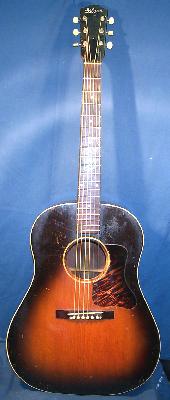
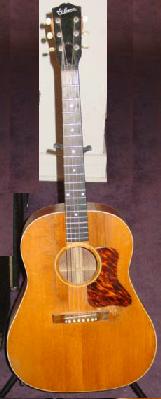
Jumbo 35 (J-35) & Gibson Trojan Flattop
Available: 1936 to 1942
Collectibility Rating: B+.
Gibson introduced this low-cost
model during the depression because the $60 Jumbo
was not selling well. The J-35 was essentially a lower
cost Jumbo model with several changes ($35 initially, though the price increased to $47.25
by 1941 for a natural finish J-35). Initially the J-35 was introduced
as a Gibson Trojan, but the name was quickly changed to J-35 (there really
very little difference between a Trojan and the J-35). These changes gave the J-35
a lower cost, but also a smoother tonal response, compared to the
Jumbo's big raw quick sound. About 3000 Jumbo 35 models were made,
more than any other pre-WW2 Gibson flat top. The J-35 was also made
in about four different bracing variations: three tone bars with
scaloped or non-scaloped braces (1936-1939), and two tone bars with
scaloped or non-scaloped braces (1939-1942).
- Oct-Dec 1936 Gibson Trojan guitar introduction specs:
-
deeper "non-tapered" body like the Gibson Jumbo
(16" wide, 20 1/4" long, 4 1/4" deep, 3 3/4" hole diameter), French heel style neck heel
"V" neck, no neck binding, dot fingerboard inlays, 19 frets, truss rod.
Black peghead with white "Gibson" script logo.
Firestripe pickguard and small Brazilian rosewood rectangle bridge and fingerboard.
Scaloped top braces with three tone bars, spruce top, mahogany back/sides/neck,
w/b/w soundhole rosette, single bound top, no back binding.
Gibson only made this mode for a very very short time during October to
December of 1936, and only one batch of 40 (FON 960). This model name morphed into the J-35.
The only difference between a J-35 and a Trojan is the the Trojan has no back body binding,
and the back is more of a redish mahogany color (instead of a brown mahogany like a J-35).
- December 1936 Jumbo 35 introduction specs:
- $35 retail list price, 16" wide, round
shoulder dreadnought shape, dark red finished mahogany back and sides, three-on-a-plate
plasitc button tuners (often Kluson), single bound top, no back binding, no neck binding,
4" soundhole, rectangle bridge with two tiny bridge screws (and hence two pearl dots),
top braces not scalloped (usually), "X" bracing with three tone bars, "V" shaped mahogany neck,
pointy French neck heel, 24.75" scale length,
dot fingerboard inlays, rosewood fingerboard,
white silkscreened peghead "Gibson" logo, "medium" sized
sunburst top, red mahogany back and side finish.
- 1937 Jumbo 35 specs:
- back binding added, some models
seen with scalloped top braces, "large" size top sunburst finish, $37.50 retail list price.
- 1939 Jumbo 35 specs:
- neck shape now rounded and not "V", rounded neck heel,
"X" bracing changed and moved closer to the soundhole and two tone bars, available on in
natural finish (though sunburst was also sometimes seen).
Back, sides and neck are a chocolate brown color on the natural colored models.
- 1941 Jumbo 35 specs:
- sunburst or natural finish available.
$40 list price for
sunburst, $45 list price for natural, which was changed to
$42 list price for sunburst and $47.25 for natural, in late 1941.
- J-35 discontinued late 1942 and replaced by the J-45.
Back to the Gibson General Info
Back to the Table of Contents
Contact the collector
1935 Advance Jumbo
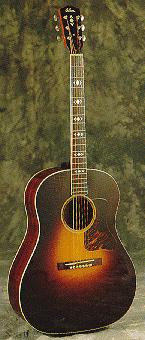
-
Advanced Jumbo Flattop
- Late 1935 Advanced Jumbo introduction specs:
- $80 retail list price,
16" wide, round
shoulder dreadnought shape, rosewood back and sides, single bound top,
back and fingerboard, diamond and arrowhead fingerboard inlays, 25.5" scale length,
larger 4" soundhole and slightly narrow waist than the Jumbo model,
1" below the soundhole "X" bracing at 105 degrees with two tone bars,
1 1/8" wide maple bridge plate, 6.1" long x .910" wide rectangle bridge
with two tiny bolts covered by two pearl dots,
mahogany "V" neck finished in brown, neck heel is rounded and has a slight sunburst finish on it,
vertical diamond and arrowhead peghead inlay, flamed celluloid pickguard, sunburst finish on top.
- 1938 Advance Jumbo specs:
- the size of the sunburst top pattern is larger,
with more yellow area.
- Advanced Jumbo discontinued early 1940, after about 300 were made. Re-introduced in 1990.
Available: 1935 to 1940
Collectibility Rating: A+.
Considered by many to be Gibson's best 16" flattop model because of its tone, clarity, power and balance in sound. A model I would love to own. Please email me if you have one for sale.
Back to the Gibson General Info
Back to the Table of Contents
Contact the collector
1930's Roy Smeck Stage Deluxe,
original condition. Note the neck
width looks WIDE; it is!!
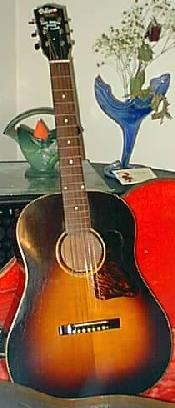
-
Roy Smeck Stage Deluxe (Hawaiian) Flattop
- 1934 Roy Smeck Stage Deluxe introduction specs:
- $50 retail list price,
16" wide, round
shoulder dreadnought shape, mahogany back and sides, spruce top,
Hawaiian neck with a raised nut,
single bound top and back, pickguard follows contours of body edge,
12 frets clear of the body, ivoroid fret lines flush with fingerboard,
dot fingerboard inlays, fingerboard 2 1/4" wide at nut,
heavier bracing than spanish Jumbo models, silkscreened
model name and "Gibson" logo on peghead, sunburst finish.
- 1939 Roy Smeck Stage Deluxe specs:
- Varied pattern fingerboard
inlays.
- Roy Smeck Stage Deluxe discontinued 1942.
Available: 1934 to 1942
Collectibility Rating: C- (in original hawaiian set up).
A great "X" braced, jumbo sized, 12 fret flattop from the 1930's. They sound absolutely amazing. Unfortunately, they are set up from the factory to be played hawaiian style. To make this a viable spanish style guitar, the following must be done: neck reset for proper angle, neck narrowed (and hence refinished) to a standard size (original neck is HUGE at 2.25" wide, and can't be played spanish), frets added (stock there are just white lines, but no frets!), bridge saddle angled for proper intonation. Obviously this ruins much of the originality of the guitar, and costs around $800 (or more!) to have it done properly. A collector/players nightmare! Do you have it converted to make it playable, yet unoriginal? Or do you leave it alone to keep it original, but essentially unplayable? A "catch22" for sure. Since a nice guitar.
Back to the Gibson General Info
Back to the Table of Contents
Contact the collector
1934 Roy Smeck Radio Grande.
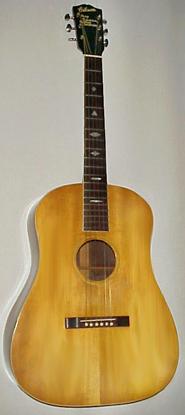
Roy Smeck Radio Grande (Hawaiian) Flattop
Available: 1934 to 1939
Collectibility Rating: B- (in original hawaiian set up).
Again, another great "X" braced, jumbo sized, 12 fret flattop from the 1930's.
They sound absolutely amazing. Unfortunately,
they are set up from the factory to be played hawaiian style. To make
this a viable spanish style guitar, the following must be done: neck reset
for proper angle, neck narrowed (and hence refinished)
to a standard size (original neck is HUGE at 2.25" wide,
and can't be played spanish), frets added (stock there are just white
lines, but no frets!), bridge saddle angled for proper intonation.
Obviously this ruins much of the originality of the guitar, and costs
around $800 (or more!) to have it done properly. A collector/players nightmare!
Do you have it converted to make it playable, yet unoriginal? Or do you
leave it alone to keep it original, but essentially unplayable?
A "catch22" for sure. But still a nice guitar that I would love to find.
- 1934 Roy Smeck Radio Grande introduction specs:
- $100 retail list price,
16" wide, round
shoulder dreadnought shape, rosewood back and sides, spruce top, Hawaiian neck with raised nut,
bound top and back, 12 frets clear of the body, ivoroid fret lines flush with
fingerboard, varied pattern fingerboard inlays with notched diamond at
3rd fret, fingerboard 2 1/4" wide at nut, bound fingerboard, heavier bracing
than spanish Jumbo models, silkscreened
model name and "Gibson" logo on peghead, natural finish.
- Roy Smeck Radio Grande discontinued 1939.
Back to the Gibson General Info
Back to the Table of Contents
Contact the collector
1940 J-55 with moustache bridge.
Photo by Folkway Music.
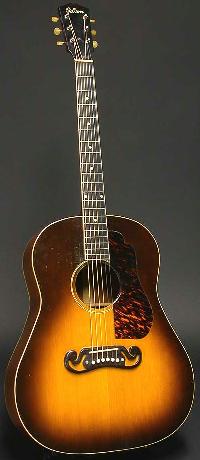
Available: 1939 to 1942
Collectibility Rating: Moustache Bridge models: A, Batwing bridge models: B+.
Introduced as a slightly fancier J-35. About 400 of the J55 was made, and I would love to find one! Please contact me if you have one for sale.
- 1939 Jumbo 55 (J-55) introduction specs:
- $55 retail list price,
16" wide, 10 5/8" wide at the waist,
20.25" long body, 4 3/16" thick, round
shoulder dreadnought shape, mahogany back and sides and neck,
fire strip "terraced" pickguard does not
follow contour of body edge, open moustache shaped bridge with cutouts at
bridge ends and two pearl dots, bridge pins in a semi-circular pattern,
one piece saddle, bound "coffeewood"
(ebony) fingerboard, dot fingerboard inlays, pearl "fat" peghead "Gibson" logo,
stairstep peghead shape, bound top and back and neck, individual Kluson
tuners with amber buttons,
baseball bat style neck shape, round neck heel, 25.5" scale length,
sunburst finish.
- 1940 J-55 specs:
- standard Gibson peghead shape (too hard/expensive to make
the stair step pattern).
- 1941 J-55 specs:
- a 3-point "batwing" rosewood bridge with beveled edges and 3 pearl
dots replaces the moustache bridge, bridge pins in a straight line,
rosewood fingerboard, 24.75" scale length,
often a white line inlaid down the center of the fingerboard,
less expensive white button tuners now used, a few made with rosewood
back/sides or rosewood sides and mahagany back.
- J-55 discontinued late 1942 (retail price at discontinuation was $68.25). Re-introduced 1973 with different specs.
Back to the Gibson General Info
Back to the Table of Contents
Contact the collector
A reissue J-100.
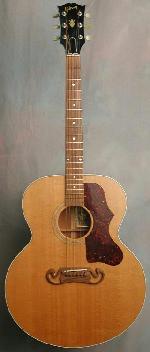
Super Jumbo 100 (SJ-100) Flattop
Available: 1939 to 1943, and reissued in the 1990s.
Collectibility Rating: A.
This model was a less
expensive version of the J-200. A great model, please
contact me if you have one for sale.
- 1939 Super Jumbo 100 (SJ-100) introduction specs:
- 17" wide, jumbo shape,
mahogany back and sides, pickguard does not follow contour of body edge,
large moustache shape bridge with cutouts at bridge ends, adjustable
saddle bearings (this feature sounded terrible),
2 pearl dots on bridge, wide triple binding on top,
single bound back and ebony fingerboard with pointed end, dot fingerboard
inlays, maple neck, pearl logo, stairstep peghead shape, butterfly
tuner buttons, sunburst finish.
- 1941 SJ-100 specs:
- Rosewood bridge with beveled edges and
3 pearl dots, 1 piece saddle (which sounded much better than the
individual saddle bearings), standard Gibson peghead, round tuner buttons.
- SJ-100 discontinued 1943. Re-introduced 1985.
Back to the Gibson General Info
Back to the Table of Contents
Contact the collector
1943 Southern Jumbo with
"banner" logo and "skunk stripe".
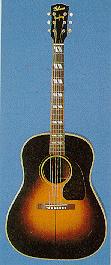
- Southern Jumbo (SJ), Country Western, SJN, SJN Country Western Flattops
- 1942 Southern Jumbo introduction specs:
- 16" wide, round shoulder dreadnought shape, mahogany back and sides and neck, mahogany neck and neck block, bottom belly bridge (belly towards endpin, which was the opposite of what all other flattop Gibsons used after WW2) with 2 pearl dots, some models with rectangular bridge instead of a bottom belly bridge, multiple bound top and back, constrasting wood strip down center of the back, neck heel sometimes caped with white celluloid, fire striped teardrop shaped pickguard, double parallelagram pearl fingerboard inlays, "Only a Gibson is Good Enough" gold silkscreened banner logo, unbound rosewood fingerboard with 19 frets, some with ebony or maple non-adjustable truss rod, multiple soundhole purfling, sunburst finish. Two batches of rosewood back and side SJ's were made, FON batch number 910 and 2005.
Available: 1942 to present
Collectibility Rating: 1940's models: B+. 1950's models: B-. 1960's square shoulder models: D-.
Rumor has it Gibson made this model for their sales reps below the Mason-Dixon line. Basically the SJ was a replacement for the J-55. The Southern Jumbo is a great model, basically a fancier version of the J-45. An excellent model, fairly easy to find but a great guitar. I love this model, especially the "banner logo" versions!
- 1943 Southern Jumbo specs:
- tortoise grain pickguard material, no neck heel celluloid cap. Many made with poplar neck block (instead of mahogany) and non-adjustable ebony or maple truss rod, and some with a black "skunk stripe" down the center of the top. Also laminated maple necks were quite common. Laminated maple back and sides are also sometimes seen (rare).
- 1944 Souther Jumbo specs:
- adjustable truss rod is the norm.
- 1946 Southern Jumbo specs:
- No "Only a Gibson..." banner, but still used old style "Gibson" gold script logo.
- 1947 Southern Jumbo specs:
- Bound fingerboard, fingerboard inlays now pearloid (celluloid, instead of pearl).
- 1948 Southern Jumbo specs:
- new style "Gibson" gold block logo.
- 1949 Southern Jumbo specs:
- "top belly"
bridge (belly towards soundhole, as used on most other flat tops models of this period).
This style of belly bridge is better, as the belly does not interfere with
the vibration of the top between the bridge and the endpin.
- 1954 Southern Jumbo Natural (SJN) specs:
- natural finish offered and called the "SJN" ("N" for natural top).
- 1955 SJN/Country Western specs:
- SJN natural finish now called the "Country Western."
Pearl "Gibson" peghead logo replaces gold silkscreen, and pearl crown peghead design added
to this model (both SJN and Country Western seen with pearl peghead attributes in 1955.)
- Mid to late 1955 Southern Jumbo specs:
- Longer pickguard with point at upper bout, one additional fret added (20 frets total), lower non-scalloped top braces used, pickguard shape changed from teardrop to a pointed style.
- 1960 Country Western specs:
- Country Western renamed back to "SJN".
- 1961 Southern Jumbo, SJN specs:
- Adjustable saddle bridge, cherry sunburst also offered.
- 1962 SJN specs:
- SJN renamed "SJN Country Western".
- 1963 Southern Jumbo and SJN Country Western specs:
- Square shoulder dreadnought body shape, 3 point pickguard, plastic bridge.
- 1964 SJ and SJN specs:
- rosewood bridge with adjustable saddle.
- Southern Jumbo and SJN Country Western discontinued 1977, and then reintroduced in 1991 (with round shoulders). Model still available today.
Back to the Gibson General Info
Back to the Table of Contents
Contact the collector
1952 J-45 with teardrop shaped
pickguard.
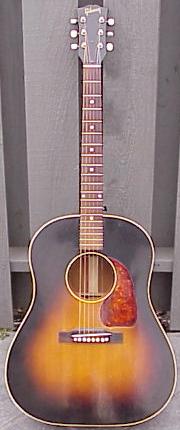
J-45 and J-45ADJ Flattop
Available: 1942 to present
Collectibility Rating: war time 1940's models: B+. Late 1940s/early 1950's models: B.
Late 1950s model: B-. 1960's models: C-.
Initially, the J-45 differed only slightly from the discontinued J-35. Internal contruction changes from the J-35 included top bracing strenghtened slightly with 1" set "X" brace behind the soundhole, tall and thin back braces, and most importantly, scalloped tall and thin top braces. Also the J-45 had a baseball bat style neck (instead of the J-35's "V" style neck, used on pre-1939 models), and a tear drop pickguard. Sunburst was the only finish available for the J-45 (or most any war-time Gibson guitar, as a sunburst finish can hide wood flaws, an important feature during WW2 when wood supplies were short). After WW2 the J-45 stayed sunburst, with a blond version being introduced in 1947 and called the J-50.
The J-45 is probably Gibson's most popular acoustic guitar ever made. At the time, they were not an expensive or fancy guitar. But they are a good one! The sound of a J-45 is very warm and fat. Playability of the J-45 is excellent too. This makes the J-45 one of the best and most popular flattop Gibsons to ever be produced. Also, since the J-45 was in production for so long, J-45s are easier to find than most any other Gibson flattop model (lucky for us!) If I was stranded on a desert island with $45 dollars to my name (the price when introduced) and could have only one Gibson flattop, a 1940s J-45 would be it!
By the late 1950s and 1960s the J-45 went through some changes, unfortunately none of them good. The worse thing Gibson did to the J-45 was to make the J-45ADJ (a J-45 with an adjustable bridge). The adjustable bridge sucked the life and tone from the J-45, and really killed the model (at least in my eye). Yes you can convert the adjustable bridge to a non-adjustable, but then it's not original any more. A "catch 22" at least to me, so I generally avoid the J-45 ADJ models.
- 1942 Gibson J-45 introduction specs:
- 16" wide, round shoulder dreadnought shape, dark brown mahogany back and sides and neck (J-35 had chocolate or dark red colored back/sides/neck), solid spruce top with scalloped X-bracing, gold silkscreened peghead logo (J-35 has white logo), slight inward "bend" of the peghead sides (J-35 has straight peghead sides), teardrop "firestripe" pickguard (J-35 had a pickguard which followed the body contours), 19 frets on the neck, black bridge pins, 2 pearl dots on rectangle bridge, three layer w/b/w top and back binding, tall and thin back braces, 24.75" scale, 19 frets total on fingerboard. dot fingerboard inlays, "Only a Gibson is Good Enough" gold banner logo, brown sunburst finish.
- Late 1942 Gibson J-45 specs:
- a tortoise-shell teardrop pickguard which replaced the firestripe material, single bound top and back, maple neck with a single walnut stripe down the center (3 piece neck).
- 1943 J-45 specs:
- maple neck with two walnut stripes down the center (5 piece neck), most with no truss rod (war time metal shortage), poplar neck block (instead of mahogany). Also during 1943 some J-45 models had non-bookmatched two piece spruce tops, and even some with four piece spruce tops (four piece top J-45s still sound great, though they don't look good). Even others had a black (skunk) strip down the middle of the top. Since Spruce was a restricted war-time material, many J-45 models from 1943 have a mahogany top instead of spruce.
- 1944 J-45 specs:
- most J-45s now have a truss rod, still some J-45s made with mahogany top.
- 1945 J-45 specs:
- some J-45s have laminated maple back and sides finished in a dark mahogany stain.
- 1946 J-45 specs:
- back, sides, neck again use mahogany, mahogany neck blocks also again used, and the banner "only a gibson is good enough" logo is gone (but the old style "gibson" script gold logo is retained).
- 1947 J-45 specs:
- the J-45's blond brother, the J-50, is introduced. The J-50 is identical to the J-45, except the top is natural instead of sunburst.
- 1948 J-45 specs:
- newer post-war gold "Gibson" block logo.
- 1950 J-45 specs:
- Upper belly bridge (belly towards sound hole) with white pins replaces the rectangle bridge, fabric side supports discontinued, triple bound top.
- 1952 J-45 specs:
- fabric side supports are no longer used.
- 1955 J-45 specs:
- shorter unscalloped top braces replaces the taller scalloped braces, larger pickguard with point at upper bout, an additional 20th fret added to the fingerboard.
- 1956 J-45 specs:
- Adjustable bridge saddle optional (called a J-45ADJ; not desirable due to decrease in tone!)
- 1959 J-45 specs:
- larger frets are now standard. Sunburst finish changes slightly to a cremona brown going from the center amber to a redish brown at the outside.
- 1961 J-45 specs:
- Adjustable bridge saddle standard. Larger 2.25" wide by .140" thick laminated maple bridge plates used instead of the earlier 1 7/16" x .125" thick solid maple bridge plates.
- 1962 J-45 specs:
- Cherry sunburst standard.
- 1963 J-45 specs:
- Injection molded .075" thick styrene pickguard replaces the older .025" thick celluloid pickguard. Plastic bolt-on bridge replaces the rosewood bridge (this style bridge was probably Gibson's worst idea ever! Because of this, many plastic bridge models have bridges replaced with a standard rosewood glued bridge).
- 1964 J-45 specs:
- standard rosewood bridge used again.
- 1966 J-45 specs:
- "gibson" logo added to the pickguard.
- 1967 J-45 specs:
- Some produced with Tobacco sunburst (instead of cherry sunburst).
- 1968 J-45 specs:
- White pickguard with "Gibson" logo, screwed to the top. Much larger top braces used, and a huge solid wood bridge plate and big bottom-belly (belly towards end pin) bridge.
- 1969 J-45 specs:
- Square shoulder dreadnought body shape. Scale length increases from 24.75 to 25.5"
- J-45 discontinued 1982. Re-introduced with different specs 1984.
Back to the Gibson General Info
Back to the Table of Contents
1963 J-50
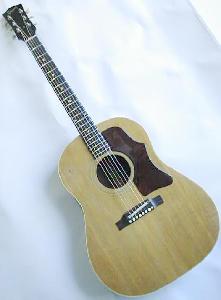
J-50 Flattop
Available: 1947 to present
Collectibility Rating: 1940's & 1950's models: C, 1960's
models: C-.
Blond version of the J-45.
See the J-45 section above for more details on this model.
Personally I like the sunburst J-45 look better, but the J-50 is
still the same guitar in a natural finish.
- 1947 J-50 introduction specs:
- Natural finish version of J-45. 16" wide, round shoulder dreadnought shape, mahogany back and sides, solid spruce top with scalloped X-bracing, black bridge pins, 2 pearl dots on rectangle bridge, teardrop pickguard shape, single bound top and back, dot fingerboard inlays, gold logo, natural finish.
- 1950 J-50 specs:
- Upper belly bridge (belly towards soundhole), triple bound top.
- 1955 J-50 specs:
- Larger pickguard with point at upper bout. Bracing change to lower non-scaloped braces, an additional 20th fret added to the fingerboard.
- 1956 J-50 specs:
- Adjustable saddle optional.
- 1961 J-50 specs:
- Adjustable saddle standard.
- 1963 J-50 specs:
- Injection molded .075" thick styrene pickguard replaces the older .025" thick celluloid pickguard. Plastic bridge used.
- 1964 J-50 specs:
- rosewood bridge with adjustable saddle.
- 1968 J-50 specs:
- White pickguard with "Gibson" logo, screwed to the top.
- 1969 J-50 specs:
- Square shoulder dreadnought body shape.
- J-50 discontinued 1982.
Back to the Gibson General Info
Back to the Table of Contents
Contact the collector
1955 J-200
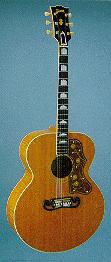
- Super Jumbo 200 (SJ-200) and J-200 Flattop
- 1938 SJ-200 introduction specs:
- 17" wide, jumbo shape, rosewood back and sides, three piece laminated maple neck (with a rosewood contrasting center stripe), large open moustache shape ebony bridge with cutouts at bridge ends, 4 semi-rectangular pearl inlays on bridge, 6 individual height adjustable saddle bearings, celluloid pickguard with engraved flower motif and engraved border around pickguard, mutliple bound top (9 layers) and back, single bound ebony fingerboard with pointed end, crest fingerboard inlays, triple bound peghead, 20 frets total, crown peghead inlay, pearl logo, stairstep tuner buttons, strap-fastening bracket on back of peghead, gold plated parts, "zipper" stripe down center of the back, two "X" top braces (lower 128 degree "X" bracing 7/8" from the soundhole, upper 128 degree "X" brace 3/4" from the soundhole), sunburst finish. Retail price was $200. For an additional $50, you could have your name inlaid in the fingerboard!
Available: 1938 to present
Collectibility Rating: Rosewood models: A+, Maple models: B+.
A very fancy Gibson flattop. Unfortunately, because of the maple design, the maple back and side J-200 does not have the warmth in sound of the J-45 and other mahogany or rosewood models. Lots of treble and bite to the sound. This is why rosewood J-200's are so nice (warmer tone). I love the rosewood versions, but the maple ones are still a beautiful guitar.
- 1941 SJ-200 specs:
- 1 piece saddle, rosewood fingerboard, pearloid tulip-shaped tuner buttons. Note no examples seen from 1944 to 1946 (war time).
- 1942 SJ-200 specs:
- single "X" brace top pattern used.
- 1947 SJ-200 specs:
- Maple back and sides, single bound peghead, no strap bracket on peghead.
- 1948 SJ-200 specs:
- Natural finish optional, body depth increased from 4.5" to 4.75".
- 1952 SJ-200 specs:
- Body depth increased to 4 7/8". Changed the bracing pattern from single X-brace with two transverse tonebars, and reinstated the wide-angled double X with two ladder style tonebars and long bridge plate.
- 1955 J-200 specs:
- Model name shortened to "J-200", laminated back and sides, molded pickguard with flower motif changed slightly, no engraved border around pickguard.
- 1959 J-200 specs:
- Grover tuners, large frets.
- 1961 J-200 specs:
- Tune-o-matic adjustable metal bridge, 4 pearl bridge inlays replace bridge cutouts in addition to previous pearl bridge inlays ("closed" moustach bridge replaces "open" moustach bridge). Bridge pins repositioned to imitate the now missing bottom cutaway in the bridge. Larger one piece neck block now wraps around under the fingerboard extention, and a larger maple bridge plate is used. The strangest change is the addition of a large, suspended wooden brace under the top, between the bridge and the soundhole. In the middle of the brace is a large metal screw, held against the top. Apparently this brace was added to keep the front of the bridge from sinking. two versions of this brace were used. But both totally killed the J-200's tone, so many owners removed this brace.
- 1963 J-200 specs:
- triangle metal tuners used, five piece laminated maple neck.
- 1968 J-200 specs:
- Grover tuners again used.
- Still in production today with slightly different specs.
Back to the Gibson General Info
Back to the Table of Contents
Contact the collector
1955 J-185
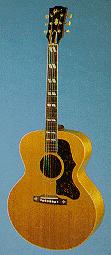
- J-185 Flattop
- 1951 J-185 introduction specs:
- 16" wide jumbo body shape, maple back and
sides, 2 pearl Maltese cross inlays on the top belly (belly towards soundhole)
bridge, triple bound top and back, mahagony neck, tortoise shell pickguard with a point,
24.75" scale length, tall scaloped braces,
single bound rosewood fingerboard with 19 frets, double parallelagram fingerboard inlays,
pearl logo, crown peghead inlay, gold plated parts, individual "tulip" button
Kluson tuners, natural or sunburst finish.
- 1955 J-185 specs:
- shorter non-scaloped braces used, an additional 20th
fret added to the fingerboard.
- J-185 discontinued 1958. Re-introduced with different specs in 1990.
Available: 1951 to present
Collectibility Rating: B+.
This is an amazing jumbo guitar by Gibson. Though they didn't make a ton of these in the 1950s, it's a great guitar. The feel, size and sound is very punchy, but not as dry sounding as a J-200. Also the look of the bridge and maple back and sides is very impressive. The mahogany neck seems to smooth out the maple, making the J-185 a better sounding guitar than the J-200. A great model!
Back to the Gibson General Info
Back to the Table of Contents
Contact the collector
1952 CF-100 acoustic
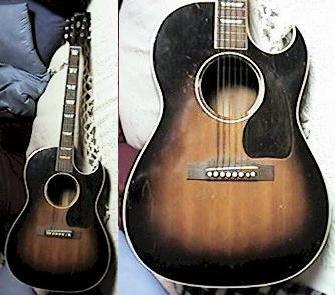
CF-100 (acoustic), CF-100e (electric) Flattops
Available: 1950 to 1959
Collectibility Rating: C+.
The only 1950s Gibson flat top with a cutaway. This is a well
made guitar with a good sound. The electric CF-100e is a way
better guitar than the plywood ladder braced J-160e. Unfortunately
the electrified Gibson flattops don't sound too good in electric mode
though.
- 1950 CF-100 introduction specs:
- 14 1/8" wide (LG sized), pointed cutaway, solid "X" braced spruce top with scaloped braces, solid mahogany back and sides, teardrop pickguard, upper belly bridge (belly towards soundhold), bound rosewood fingerboard with 20 frets, trapezoid fingerboard inlays, gold decal logo, sunburst finish.
- 1951 CF-100e introduction specs:
- CF-100e (electric) same specs as CF-100, but with a single coil P-90 pickup with adjustable poles at end of fingerboard. Because of the pickup, the soundhole is moved a bit closer to the bridge.
- 1952 CF-100, CF-100e specs:
- Pearl logo, crown peghead inlay.
- 1955 CF-100, CF-100e specs:
- Pickguard enlarged, lower scaloped braces.
- CF-100, CF-100e discontinued 1959.
Back to the Gibson General Info
Back to the Table of Contents
Contact the collector
1957 J-160e with replaced bridge.
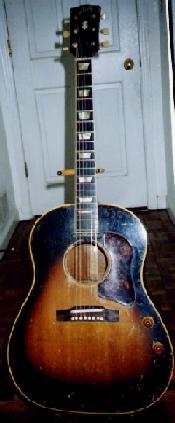
-
J-160e Electric Flattop
- 1954 J-160e introduction specs:
- 16" wide, round shoulder dreadnought shape, solid spruce top with ladder bracing, solid mahogany back and laminated sides, single coil adjustable pole pickup at end of fingerboard, 15 frets clear of the body, crown peghead inlay, pearl logo, two large adjustment knobs on the top belly bridge (first Gibson flat top with an adjustable bridge), two large dots inlaid on bridge, bound top, back and rosewood fingerboard with 19 frets, 24.75" scale, trapazoid fingerboard inlays, teardrop pickguard shape, brown sunburst finish. The pickup used is a cover-less P-90, with a single volume and tone control knob drilled into the edge of the top. The 15 frets clear of the body style neck was used to make room for the pickup, which was mounted at the end of the fingerboard.
Available: 1954 to present
Collectibility Rating: 1954 model: B+, 1955-1959 models: C, 1960's models: D+
Except for the introduction year of 1954, the J-160e had a plywood top. This combined with the ladder bracing instead of "X" bracing somewhat limits the acoustic sound (and collectibility). Hence they sound pretty bad acoustically. Also the bridge was adjustable, which never helps the tone. To make matters worse, the pickup makes the guitar sound like an electric guitar instead of an amplified acoustic guitar. The story goes the Gibson J-160e was originally going to be the "Les Paul Flattop", but Les would not sign-off on the model with the solid spruce top (which would feedback much more than a laminated 3-ply top). So by 1955 Gibson changed the J-160e's top (and back) to plywood (but Les still never endorsed the model). The Beatles liked and used them, hence they have some collectibility for pretty much that reason alone.
- 1955 J-160e specs:
- fingerboard now has 20 frets total, 3-ply laminated top, back is now usually laminated too.
- 1960 J-160e specs:
- Smaller adjustable saddle screws.
- 1970 J-160e specs:
- Square shoulder dreadnought body shape.
- J-160e discontinued 1979. Re-introduced with different specs 1991.
Back to the Gibson General Info
Back to the Table of Contents
Contact the collector
1929 Gibson HG-24 guitar.
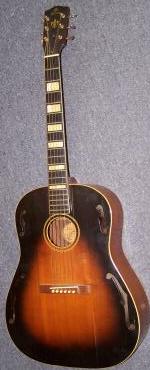
-
HG20, HG22, HG24 Flattop
- 1929-1933 Gibson HG-24 guitar specs:
- 16" wide J-45 style body, rosewood back and
sides, round sound hole, inner sound wall, two small and two large "f" holes
in the top, 14 frets clear, single bound rosewood fingerboard slightly elevated off
the top, single bound top and back, no pickguard, gold Grover G-98 tuners,
white serial number tag inside sound hole,
pearloid block fingerboard inlays, large fleur-de-lis peghead
inlay, "the Gibson" peghead logo, rectangle pin bridge, natural or sunburst finish.
- 1929-1933 Gibson HG-22 guitar specs:
- 14.25" wide L-00 style body, maple back and
sides, round sound hole, inner sound wall, two small and two large
"f" holes in the top, 14 frets clear, tortoise pickguard,
single bound top and back, unbound rosewood fingerboard slightly elevated off
the top, dot fingerboard inlays, no peghead
inlay, "Gibson" white paint logo, rectangle pin bridge, sunburst finish.
- 1929-1933 Gibson HG-20 guitar specs:
- 14.25" wide L-00 style body, maple back and sides, round sound hole, inner sound wall, two small and two large "f" holes in the top, 14 frets clear, tortoise pickguard, single bound top and back, unbound rosewood fingerboard slightly elevated off the top, dot fingerboard inlays, no peghead inlay, "Gibson" white paint logo, rectangle pin bridge, brown finish.
Available: 1929 to 1933
Collectibility Rating: the HG-24 with a 16" wide body and rosewood back and sides is the more desirable of the three HG models. (the smaller HG20/HG-22 models have 14.25" wide with maple back and sides). None of the models are highly collectible, but are interesting historic pieces.
These are rare odd guitars in that they have a normal flat top J-45 (or L-00) body style with a round soundhole. But they also have an internal inner sound wall and four small "f" holes cut into the top. Though marketed as a Hawaiian guitar, nearly all were sold set up for Spanish style playing with frets (and an added high nut adjuster). But this was the beginning for the "J" style Gibson guitars, and what the Jumbo, Advanced Jumbo, J-35, J-45 started from.
Back to the Gibson General Info
Back to the Table of Contents
1963 Everly Brothers
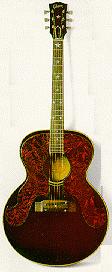
- Everly Brothers Flattop
- 1962 Everly Brothers introduction specs:
- Very similiar to a
J-185 but with a slightly thinner body. 16" wide, jumbo shape,
spruce top, maple back and sides, oversized top belly bridge with 3 pearl dots, strings anchor
thru bridge (no pins), adjustable saddle, huge double tortoise grain pickguards
extend below bridge, single white binding top & back, bound rosewood fingerboard, star fingerboard
inlays, 24.75" scale mahogany neck, pearl logo, star peghead inlay, metal tuner buttons,
gold plated parts, black finish.
- 1963 Everly Brothers specs:
- Natural top with red back and sides
optional (1963 only).
- 1968 Everly Brothers specs:
- Natural top with walnut back and sides
standard, smaller (but still big!) black laminate pickguards that do not extend below bridge.
- Everly Brother discontinued 1972. Re-introduced with different specs as the J-180 in 1986.
Available: 1962 to 1972
Collectibility Rating: 1962-1965 models: B+, 1965-1967: B, 1968-1972: C-.
Kind of a funky J-185, but I like this model. It has a small following, but I'm one of them! Please contact me if you have one for sale.
Back to the Gibson General Info
Back to the Table of Contents
1967 Hummingbird
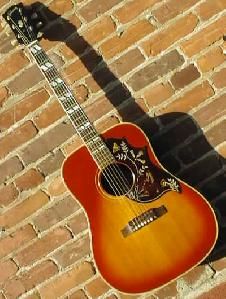
Hummingbird Flattop
Available: 1960 to present
Collectibility Rating: 1960-1965: C-, 1965-1969: D-
Because this is a square
shoulder guitar, there aren't a lot of collectors interested in this model,
even though it was Gibson's second most expensive flat top (only behind the J-200).
- 1960 Hummingbird introduction specs:
- 16.25" wide, Gibson's first square shoulder dreadnought, mahogany back and sides (often the side was laminated), adjustable saddle on the rosewood top belly bridge, 3-ply maple bridge plate, single "X" braced spruce top, pickguard with 2 points on upper treble bout and 1 point level with bridge, engraved hummingbird on pickguard, multiple bound top, bound fingerboard with double parallelagram inlays, 24.75" scale mahogany neck, crown peghead inlay, gold tuners, cherry sunburst finish.
- 1962, 1963 Hummingbird specs:
- Some with maple back and sides, $250 list price.
- 1963 Hummingbird specs:
- Natural top finish with cherry back and sides optional. Pickguard slightly reduced in size.
- 1965 Hummingbird specs:
- The sides around the neck and at the end pin sometimes painted black. This hides where Gibson over-sanded the body, and sanded through the top layer of the mahogany laminated side!
- 1968 Hummingbird specs:
- Bottom belly bridge that is more squarish, some with tobacco sunburst, some pickguards attached with screws.
- 1969 Hummingbird specs:
- Bracing changed to be large and bulky, with tone suffering.
- 1970 Hummingbird specs:
- Non-adjustable bridge saddle, laminate 3 piece mahogany neck.
- 1971 Hummingbird specs:
- Double "X" bracing used.
- 1973 Hummingbird specs:
- Block fingerboard inlays.
- 1984 Hummingbird specs:
- Back to double parallelagram fingerboard inlays.
Back to the Gibson General Info
Back to the Table of Contents
Contact the collector
1967 Dove
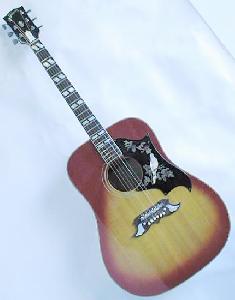
Dove Flattop
Available: 1962 to present
Collectibility Rating: 1962-1965: C, 1965-1969: D.
Because this is a square
shoulder guitar, there aren't a lot of collectors interested in this model.
When introduced, it became Gibson's second from the top flat top model.
- 1962 Dove introduction specs:
- 16.25" wide, square shoulder dreadnought, maple back and sides, mahogany neck, tuneomatic bridge inlaid into a rosewood bridge with dove-shaped pearl inlays on bridge ends, pickguard with 2 points towards bridge and 1 toward treble bout, pearl dove inlaid on pickguard, multiple bound top and back, bound rosewood fingerboard with double parallelagram inlays, crown peghead inlay, gold tuners and bridge, cherry sunburst.
- 1963 Dove specs:
- natural finish available with cherry back and sides.
- 1965 Dove specs:
- Truss rod cover changes from black with white outside line, to white with black outside line.
- 1966 Dove specs:
- pickguard no longer hand made with pearl (now a pantograph machine is used).
- 1968 Dove specs:
- Bottom belly bridge with adjustable rosewood saddle, bracing made much heavier, some pickguards attached with screws (often covered with pearl dots).
- 1970 Dove specs:
- Non-adjustable bridge saddle.
- 1971 Hummingbird specs:
- Double "X" bracing used.
- 1975 Dove specs:
- Ebony fingerboard.
Back to the Gibson General Info
Back to the Table of Contents
Contact the collector
Les Paul Jumbo Flattop
Available: 1969 to 1973
Collectibility Rating: C-
Because of the Les Paul connection, this guitar has some collectibility even though it's really past Gibson's prime collecting era.
- 1969 Les Paul Jumbo specs:
- 16.25" wide, square shoulder dreadnought, rounded cutaway, Indian rosewood back and sides, oval low-impedance pickup, 4 knobs, belly (below) bridge, backstripe, dot fingerboard inlays
- 1973 Les Paul Jumbo discontinued.
Back to the Gibson General Info
Back to the Table of Contents
Heritage Flattop
Available: 1965 to 1982
Collectibility Rating: D
Because this is a square shoulder guitar, there aren't a lot of collectors interested in this model.
- 1965 Heritage introduction specs:
- 16.25" wide, square shoulder dreadnought, solid rosewood back and sides, ebony bridge with top belly and adjustable ebony saddle, elongated teardrop tortoise pickguard, tortoise binding on top and back, 25.5" scale unbound ebony fingerboard with dot inlays, no peghead ornamentation, decal "gibson" peghead logo, natural finish.
- 1968 Heritage specs:
- laminate rosewood back and sides, black pickguard, multiple bound w/b/w top and back, diamond and curlicue peghead inlay. 12 string model available.
- 1969 Heritage specs:
- bottom belly bridge.
- 1970 Heritage specs:
- non-adjustable bridge saddle.
- Early 1970's specs:
- large block fingerboard inlay, large bridge with pointed ends and curlicue inlays.
- 1975 Heritage specs:
- black outer body binding.
- 1982 Heritage discontinued.
Back to the Gibson General Info
Back to the Table of Contents
Contact the collector
Blue Ridge Flattop
Available: 1968 to 1990
Collectibility Rating: D--
Because this is a square shoulder laminate guitar, there aren't a lot of collectors interested in this model.
- 1968 Blue Ridge introduction specs:
- 16.25" wide, square shoulder dreadnought, laminate outside rosewood layer (maple inner layers) back and sides, top belly bridge with adjustable rosewood saddle, black teardrop pickguard, bound top and back, 25.5" scale unbound rosewood fingerboard with dot inlays, no peghead ornamentation, decal "gibson" peghead logo, natural finish.
- 1969 Blue Ridge specs:
- bottom belly bridge.
- 1970 Blue Ridge specs:
- non-adjustable bridge saddle. 12 string model available.
- 1979 Heritage discontinued. Reintroduced with different specs in 1989 and discontinued in 1990.
Back to the Gibson General Info
Back to the Table of Contents
Contact the collector
1964 Gibson FJN flat top guitar.
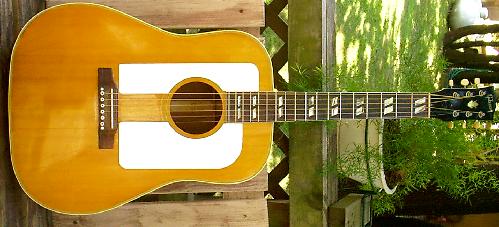
FJN (Folk Singer Jumbo) Flattop
Available: 1963 to 1967
Collectibility Rating: D-
Because it's square-shoulder, 2" wide nut, braced
for classical style strings, there aren't a lot of collectors interested in this model.
- 1963 FJN specs:
- 16.25" wide, square shoulder dreadnought, mahogany back and sides, bridge with upper belly and straight mounted saddle, double white pickguards, multiple bound top, bound fingerboard with double parallelogram inlays, crown peghead ornamentation, pearl "gibson" logo, natural top finish, deep red finish on back and sides.
- 1967 FJN discontinued.
Back to the Gibson General Info
Back to the Table of Contents
Contact the collector
J-40 Flattop
Available: 1971 to 1982
Collectibility Rating: none (too new).
- 1971 J-40 introduction specs:
- 16.25" wide, square shoulder dreadnought, walnut back and sides, no bridge pins, natural top finish.
- 1981 J-40 specs:
- Tortoise grain binding.
- 1982 J-40 discontinued.
Back to the Gibson General Info
Back to the Table of Contents
late 1940's LG-1. Note the narrow 14 1/8" body width.
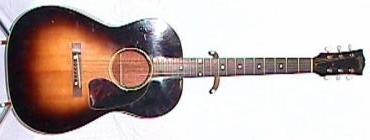
LG-0, LG-1, LG-2, LG-3, B-25, B-25N Flattops
Three LG-1, LG-2, LG-3 models were all introduced in August 1942. But the LG1 and LG3
stopped production right after introduction (only about 100 of each model was
produced in 1942), leaving just the LG-2 as the only
model made through WW2. All three models had different top/brace materials.
The LG-1 had a mahogany top and chocolate brown top finish, the LG-3 had a blond natural spruce top,
and the LG-2 had a spruce sunburst top.
So the most common war-time (banner logo) 14.25" Gibson was the sunburst LG-2.
After WW2 the LG-1 and LG-3 were reintroduced, but now the three models had
different features between them (the LG1 for example now had ladder bracing with a spruce top
and sunburst finish). In 1958 the LG-0 was introduced as the new
low-end flattop model (ladder bracing, mahogany top, brown top finish).
Collectibility: Script logo (pre-1947) LG-2, LG-3: C+, all others: D-.
The LG-2 and LG-3 due to their spruce top and "X" bracing, are much better instruments than
the LG-0 and post-WW2 LG1 models. B-25 and B-25N models, although
X-braced, are constructed with adjustable bridges and other 1960's features
that make them undesirable. Unfortunatly, since all models are essentially
student models with narrow 14 1/8" wide bodies (2" narrower than a J-45, and .5" narrower
than an L-00) and are quite plentiful, they are not real collectible (though the
script logo LG-2/LG-3 are quite good for their size and some people do collect them).
- LG-0: 1958 to 1974. mahogany top, ladder braced, natural.
- LG-1: August 1942 to 1974 (no production 1943-1945), X-braced and brown finish/mahogany top in 1942, ladder braced spruce top/sunburst finish after WW2.
- LG-2: August 1942 to late 1962. X-braced spruce top, sunburst (replaced by B-25 in late 1962)
- LG-3: August 1942 to late 1963 (no production 1943-1945). X-braced spruce top, natural top (replaced by B-25N in late 1962)
- B-25, B-25N: late 1962 to 1977. X braced spruce top. Available in 12 string version too.
- LG-1: August 1942 to 1974 (no production 1943-1945), X-braced and brown finish/mahogany top in 1942, ladder braced spruce top/sunburst finish after WW2.
All are 14 1/8" to 14 1/4" wide, mahogany back and sides (except for some WW2 models some had maple back and sides), mahogany neck (except during WW2, when maple laminated necks were used), dot fingerboard inlays, 24.75" scale length, silkscreen gold decal "Gibson" logo. The "X" braced models are decent little guitars. The ladder braced LG-0 and post-war LG1 are not very good, essentially beginner's guitars.
- 1958 LG-0 introduction specs:
- 14 1/8" wide Mahogany top,
mahogany back and sides,
straight ladder bracing, black bridge pins, screw-on black pickguard, tortoise binding on top and back,
3 on-a-plate tuners, rectangle rosewood bridge,
rosewood fingerboard, 20 frets total, 3-on-a-plate tuners, natural finish. Bridge pad
was spruce, which unfortunately would wear out from the string's ball-ends.
In 1962 plastic bridge used. $85 list price.
In 1963 an injection molded styrene pickguard was used.
In 1966 rosewood bridge with adjustable saddle was used.
In 1968 spruce top on some models.
In 1974 discontinued. - August 1942 LG-1 introduction specs:
- 14 1/8" wide Spruce top, X-bracing,
mahogany back, no lengthwise center seam on inside back,
mahogany sides, mahogany neck, rectangle bridge with black
pins, single bound top and back, sometimes darker sunburst finish (darker than the LG-2, to hide
the lower quality spruce top).
"Only a Gibson is Good Enough" banner logo.
Only about 100 made in 1942, production ceased until 1946.
In 1946 the "banner" is dropped (still a script "Gibson" peghead logo). Bracing changed to ladder.
In 1948 goes to a "block" Gibson peghead logo.
In 1955 larger pickguard with point, and 20 frets total.
In 1962 plastic upper belly bridge. $105 list price.
In 1966 rosewood bridge with adjustable saddle was used.
Discontinued in 1968 but seen as late as 1974. - August 1942 LG-2 introduction specs:
- 14 1/8" wide Spruce "X" braced top, mahogany back and sides,
single bound top and back (though some had triple bound tops),
fire stripe teardrop pickguard, 19 total frets,
rosewood fingerboard, rectangle rosewood bridge with black bridge pins, two pearl dots on bridge,
dot fingerboard inlays, 3 on-a-plate tuners, sunburst finish.
"Only a Gibson is Good Enough" banner logo.
The only small body banner logo model made in great numbers during WW2.
In 1943 standard tortoise pickguard.
1943-1945: Some war-time models have a mahogany top and/or maple back and sides. In 1946 the "banner" is dropped (still a script "Gibson" peghead logo).
In 1948 goes to a "block" Gibson peghead logo.
In 1949 a 3/4 scale (23") LG-2 was introduced, with ladder bracing.
In 1955 larger pickguard with point, 20 frets total, lower braces.
In 1961 has cherry sunburst finish, no pearl dots on bridge, $115 retail price.
In 1962 has white bridge pins.
In late 1962 replaced by B-25.
Early LG-2 models are actually a decent little guitar, since it has "X" bracing. - August 1942 LG-3 introduction specs:
- 14 1/8" wide body with
spruce "X" braced top, mahogany back and sides, triple bound top,
teardrop tortoise pickguard, 19 total frets,
rosewood fingerboard, rectangle rosewood bridge with white bridge pins,
two pearl dots on bridge, dot fingerboard inlays, 3 on-a-plate tuners, natural finish,
"Only a Gibson is Good Enough" banner logo.
The LG-3 is essentially an LG-2 with a natural top finish.
Only about 100 made in 1942, production ceased until 1946.
In 1946 the "banner" is dropped (still a script "Gibson" peghead logo).
In 1948 goes to a "block" Gibson peghead logo.
In 1955 larger pickguard with point, 20 frets total, lower braces.
In 1961 adjustable saddle.
In 1962 bridge becomes plastic upper belly, $127.50 list price.
In 1963 Replaced by B-25N. - Late 1962 B-25 introduction specs:
- Continuation of the LG-2 with minor changes such
as triple bound w/b/w top, cherry sunburst top, plastic bridge, laminated bridge plate,
thick pickguard.
In 1966 rosewood bridge with adjustable saddle was used.
Discontinued in 1977. - 1963 B-25N introduction specs:
- Basically the B-25 was the continuation
of the LG-3 with minor changes such as cherry finish on the back and sides (only), natural top,
plastic bridge, laminated bridge plate, thick pickguard.
In 1966 rosewood bridge with adjustable saddle was used.
Discontinued in 1977.
Contact the vintage guitar info guy
Back to the Gibson General Info
Back to the Table of Contents
Copyright 1995-2002 all rights reserved.